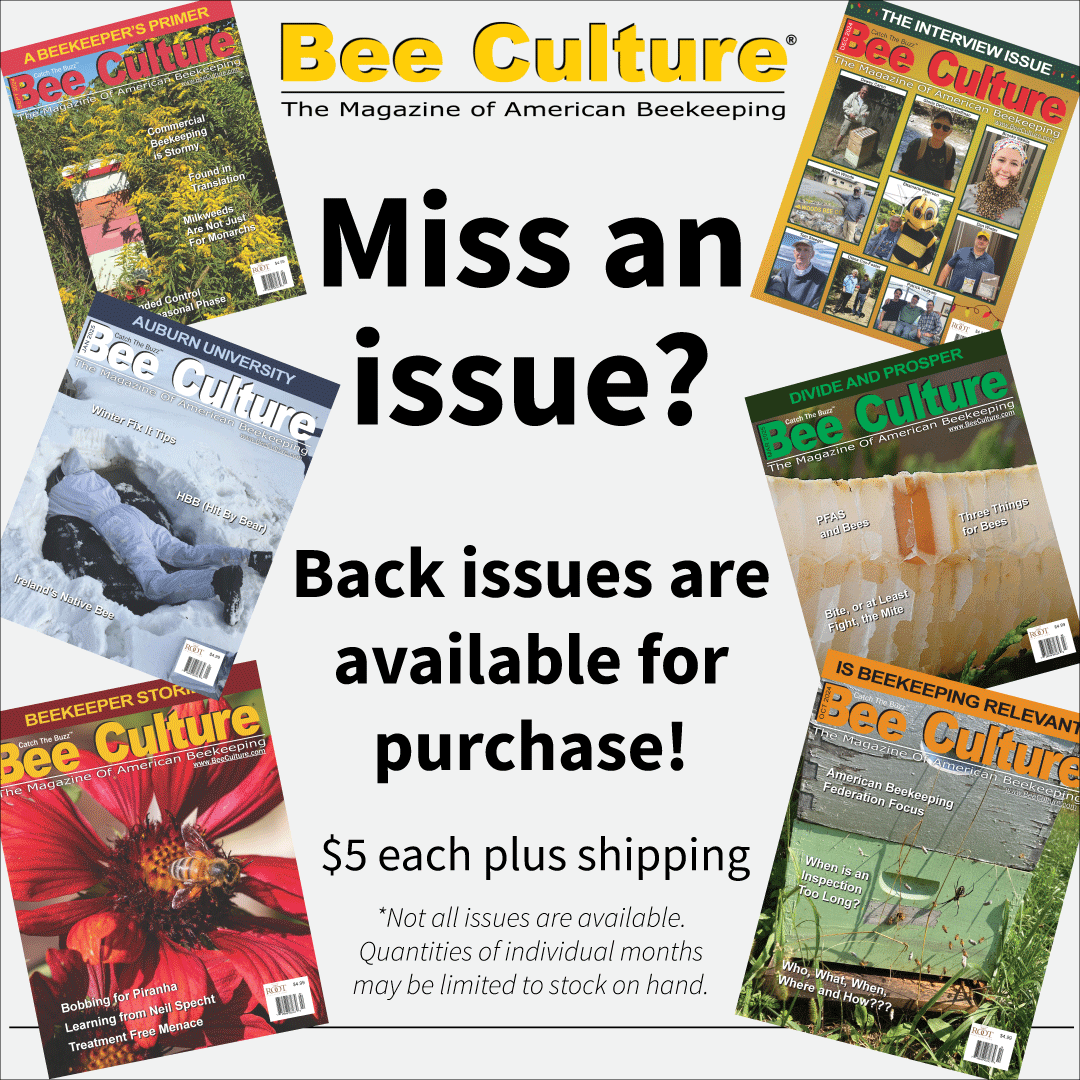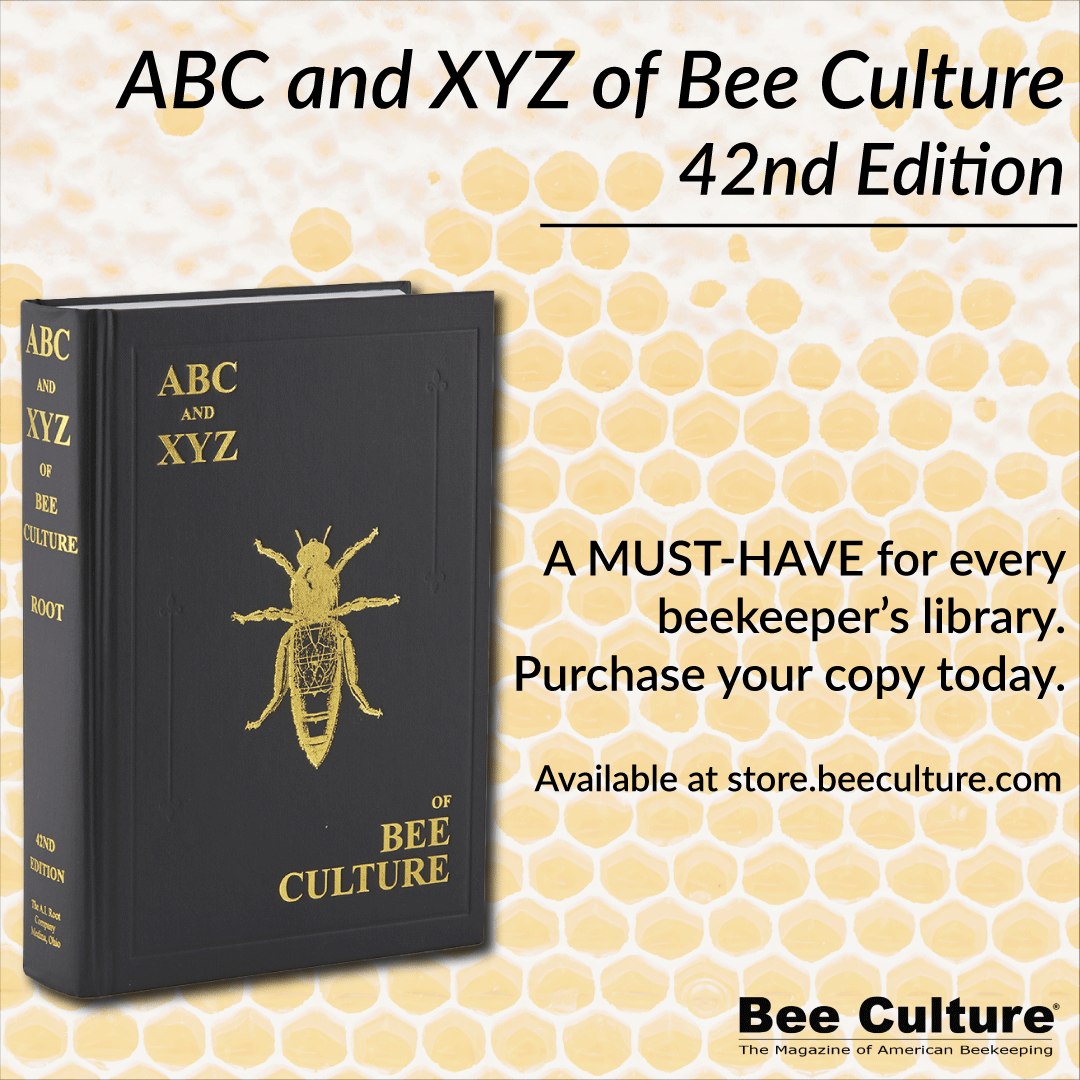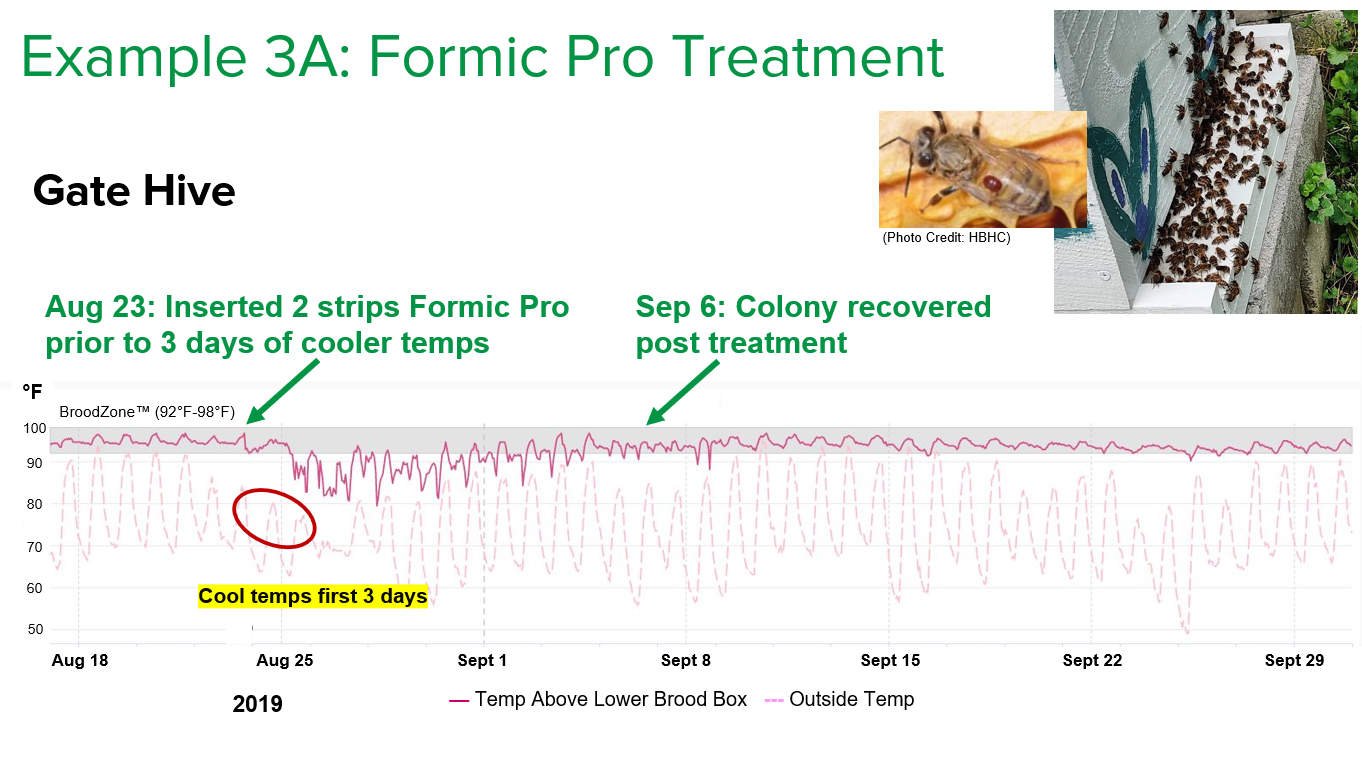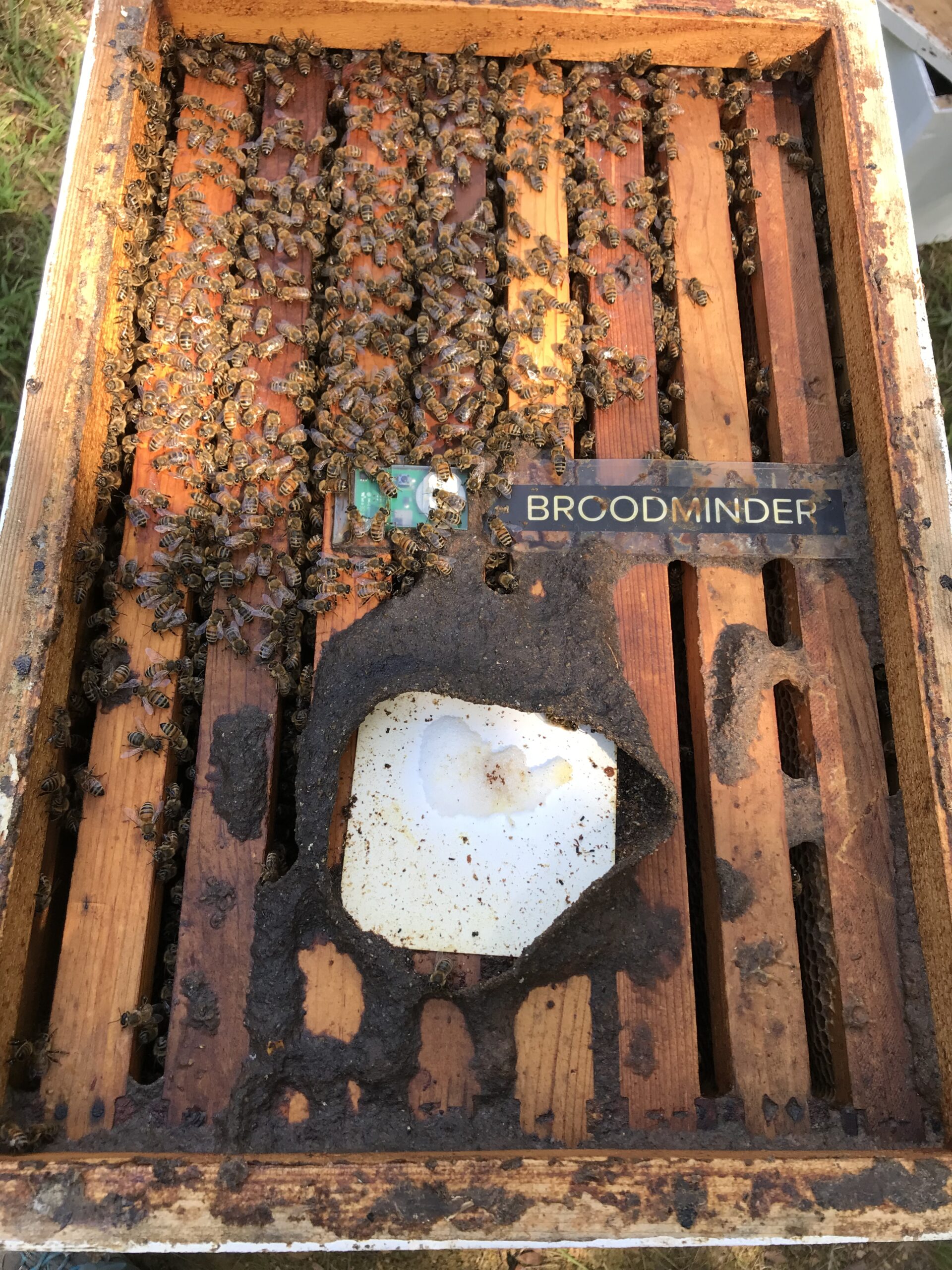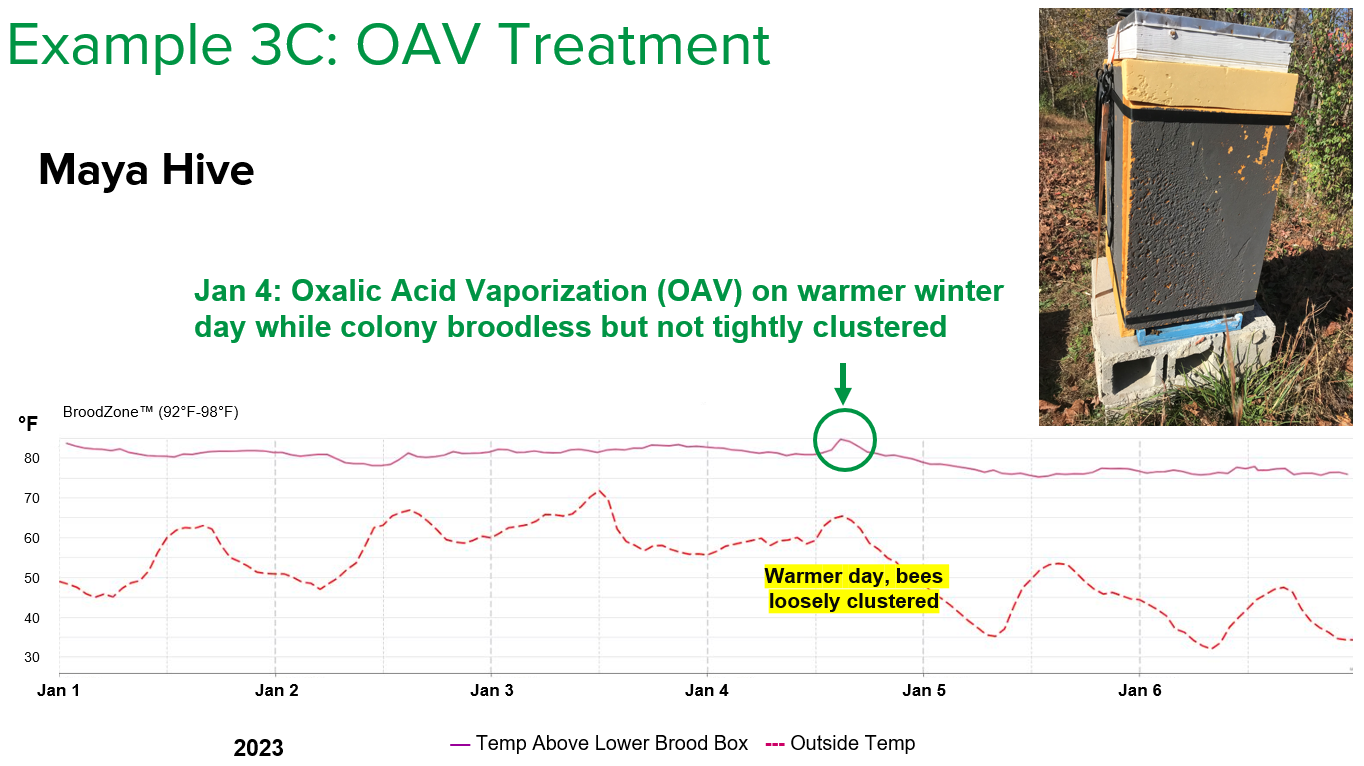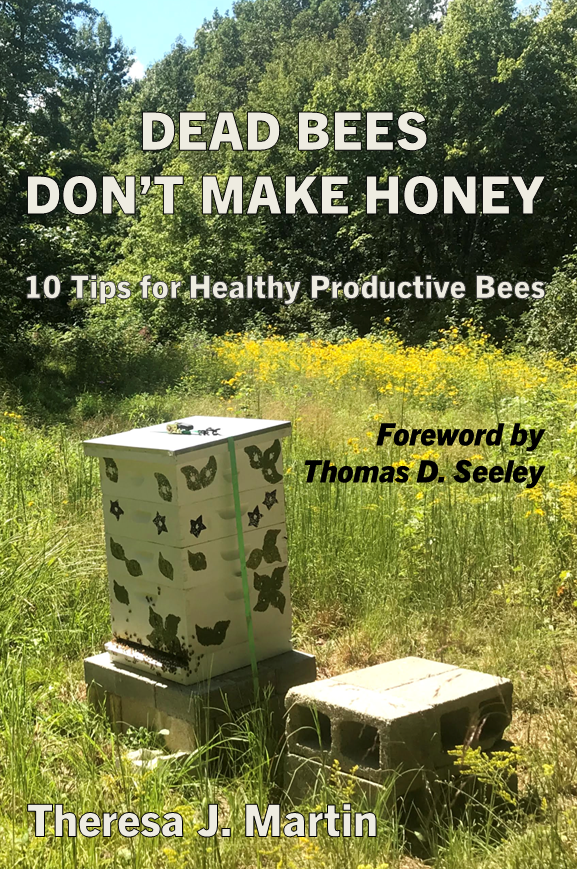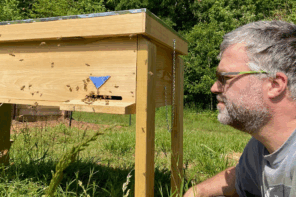Click Here if you listened. We’d love to know what you think. There is even a spot for feedback!
Read along below!
Part 3 – Take the Temperature of Your Colony:
Varroa Treatments
Theresa J. Martin
I begin by clarifying that BroodMinder does not compensate me in any way for my statements about its product. What I write is my uninfluenced opinion based solely on my experience.1
In this four-part series, we are exploring how temperature sensors provide the beekeeper with actionable information that improves colony outcomes. In April, we reviewed Example 1, which demonstrated how the BroodMinder T2SM temperature sensor technology alerted me that one of my colonies was queenless and assisted me in monitoring their return to queenright status. Last month, we explored Example 2, which showed how temperature sensors indicate that a colony swarmed and ways this knowledge improves beekeeper actions.
This month, we explore Example 3, where the temperature sensor depicts biological disruption during three Varroa destructor organic treatments and how the sensor assists the beekeeper in monitoring colony recovery post treatment.
Treatment-Less Beekeeping
I do not have the environmental conditions to practice sustainable treatment-free beekeeping due to lack of isolation, the great distances queens and drones fly to mate and recessive Varroa resistance traits. Therefore, I am what some call a “treatment-less” beekeeper, meaning I make it a priority to take as many actions as possible that assist in allowing me to treat as infrequently as possible. I extensively employ many physical and cultural integrated pest management controls, sample frequently, then treat individual colonies only when thresholds are exceeded using three of the organics: Formic Pro (formic acid), Apiguard (thymol), and oxalic acid vaporization (OAV). I use each product as directed by the label and follow the Honey Bee Health Coalition Resources for Varroa Management.2 I will elaborate on this “treatment-less” approach in a future Bee Culture article.
Example 3: Colony Disruption During Varroa Treatment
Temperature sensors are an integral part of Varroa management because they show when thermoregulation is disrupted, such as when Varroa treatments are put into the hive. All treatments can cause collateral damage which can be sublethal, impacting behavior and physiology. Treatments disturb the normal function of the colony, and in some cases, can result in reduced brood rearing, removed pupae and even queen mortality.3
As shown in Figure 1, on August 23, 2019, I treated Gate hive with two strips of Formic Pro. Per the label, Formic Pro should not be put inside the hive unless the outside temperature is below 85°F for the first three days of application. Therefore, I put Formic Pro into the hive late in the afternoon prior to several upcoming days of cooler outside temperatures. As Example 3A shows, the next three days were cool in the mid-70s. Even with this precaution, Formic Pro caused a major disruption to the colony’s thermoregulation. The two-strip method of Formic Pro is a 14-day treatment, and we can see on the graph that 14 days later on September 6, the colony resumed thermoregulating its brood nest.
Similarly, we see disruption with the use of Apiguard in Bees hive (Figure 2). On the evening of July 21, 2019, prior to three days of cooler outside temperatures, I inserted 50 grams of Apiguard into Bees hive (Example 3B). The disruption to thermoregulation is less severe, but still evident in the temperature profile. Disruption continues as I inserted the second dose of Apiguard on August 3. After the full 30-day treatment is completed, the colony recovered.
Figure 3 shows the impact of oxalic acid vaporization on Maya hive on January 4, 2023. Because it was the middle of Winter, there was little to no brood, so the majority of Varroa were in the dispersed phase (formally called the phoretic phase). OAV is most effective during broodless periods because it is a flash treatment that reaches only the dispersed Varroa. I applied OAV on a day when the temperature was warmer, so the bees would be less tightly clustered. This enables the OA vapors to more effectively penetrate the cluster to reach the dispersed Varroa. Maya hive was a deep and two mediums, so I used the legal dose per my label which was 2 grams (1 gram per brood box). The graph shows a slight increase in temperature while the bees fanned and reacted to the OA vapors. Note that I do not do repeat treatments and instead, reserve OAV for broodless periods only.
As shown in all three graphs, even these organic treatments are not benign, which is supported by research that details their negative impacts. The BroodMinder temperature sensor helps the beekeeper be more aware of the disruption caused by these treatments and more careful to apply treatments during appropriate temperatures and at the correct dosage. As detailed in a prior article, because the temperature sensor gives an indication of the queenright status of the colony, the beekeeper can use the sensor to monitor colony recovery from the treatment.
Improved Colony Health and Productivity
The temperature sensor shows that a colony undergoing Varroa treatment experiences sometimes significant disruption. The sensor provides insight into the degree of biological disturbance and assists the beekeeper in monitoring colony recovery.
Next month, we will explore how the temperature sensor can show the value of beekeeper actions, such as the effort to winterize a colony.
Theresa J. Martin is the author of Dead Bees Don’t Make Honey: 10 Tips for Healthy Productive Bees, which includes a Foreword by Dr. Thomas Seeley. Her book also provides ten examples of the value of BroodMinder temperature sensors. Theresa has achieved 99% colony survival and honey production that is twice the local average in her seven years as a beekeeper, with 20–25 colonies in Kentucky. She is a Cornell Master Beekeeper, 2024 Kentucky State Beekeeper of the Year, and Vice President of the Kentucky State Beekeepers Association. Theresa can be reached at theresa@littlewolf.farm
REFERENCES
1See www.broodminder.com for more information. I am not compensated by BroodMinder in any way, so what I share is my uninfluenced experience.
2The Honey Bee Health Coalition provides outstanding Varroa and integrated pest management resources. Honey Bee Health Coalition. (2022). The guide to effective Varroa sampling and control. https://honeybeehealthcoalition.org/wp-content/uploads/2022/08/HBHC-Guide_Varroa-Mgmt_8thEd-082422.pdf
3Underwood and Currie (2003) studied the LT50 (lethal time to kill 50% of the population) for various dosages and temperatures of formic acid fumigation. In the paper’s Discussion section, the researchers explain the challenge of achieving high efficacy to kill Varroa without killing bees. Underwood, R. M., Currie, R. W. (2003). The effects of temperature and dose of formic acid on treatment efficacy against Varroa destructor (Acari: Varroidae), a parasite of Apis mellifera (Hymenoptera: Apidae). Experimental & Applied Acarology, 29, 303-313.
Mondet, Goodwin and Mercer studied behavioral changes and adverse effects of Apiguard treatments, finding differences in response based on age, citing multiple prior studies that found Apiguard has been shown to contribute to colony agitation, absconding, and acute toxicity to honey bees. Mondet, F., Goodwin, M., Mercer, A. (2011). Age-related changes in the behavioural response of honeybees to Apiguard, a thymol-based treatment used to control the mite Varroa destructor. Journal of Comparative Physiology, 197:1055-1062. DOI 10.1007/s00359-011-0666-1
Multiple studies have quantified the impact of OAV on queens, workers, drones and entire colonies, with variation in their conclusions, suggesting more research is needed to especially quantify sublethal and long-term impacts. Here are two such studies. Prieto, E. E., et al. (2024). Safety assessment of high doses of vaporized oxalic acid on honey bee worker health and queen quality. Frontiers in Bee Science, 2-2024. https://doi.org/10.3389/frbee.2024.1442030. Rademacher, E., Harz, M., Schneider, S. (2017). Effects of oxalic acid on Apis mellifera (Hymenoptera: Apidae). Insects, 8(3), 84. https://doi.org/10.3390/insects8030084




